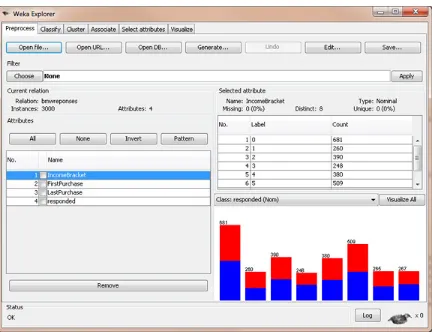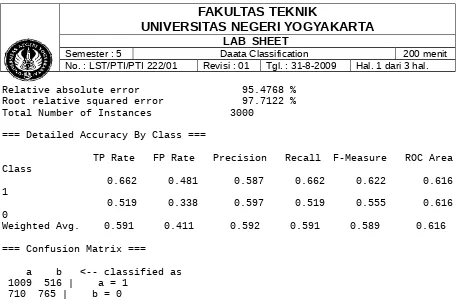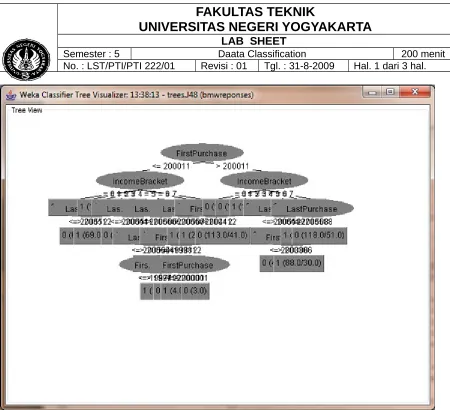Handaru Jati, Ph.D
Universitas Negeri Yogyakarta
Classification
Classification
(also known as classification trees or decision trees) is a data mining algorithm
that creates a step-by-step guide for how to determine the output of a new data instance. The
tree it creates is exactly that: a tree whereby each node in the tree represents a spot where a
decision must be made based on the input, and you move to the next node and the next until
you reach a leaf that tells you the predicted output. Sounds confusing, but it's really quite
straightforward. Let's look at an example.
Listing 1. Simple classification tree
[ WillYou Read This
Section? ] /
\
Ye s
No
/ \
[Will You Understand It?]
[Won't Learn It] / \
Yes No
/ \
[Will Learn It] [Won't Learn It]
instance, and you are able to predict whether this unknown data instance will learn
classification trees by asking them only two simple questions. That's seemingly the big
advantage of a classification tree — it doesn't require a lot of information about the data to
create a tree that could be very accurate and very informative.
One important concept of the classification tree is similar to what we saw in the regression
model from
Part 1
: the concept of using a "training set" to produce the model. This takes a
data set with known output values and uses this data set to build our model. Then, whenever
we have a new data point, with an unknown output value, we put it through the model and
produce our expected output. This is all the same as we saw in the regression model.
However, this type of model takes it one step further, and it is common practice to take an
entire training set and divide it into two parts: take about 60-80 percent of the data and put it
into our training set, which we will use to create the model; then take the remaining data and
put it into a test set, which we'll use immediately after creating the model to test the accuracy
of our model.
Why is this extra step important in this model? The problem is called
overfitting:
If we
supply
too much
data into our model creation, the model will actually be created perfectly,
but just for that data. Remember: We want to use the model to predict future unknowns; we
don't want the model to perfectly predict values we already know. This is why we create a test
set. After we create the model, we check to ensure that the accuracy of the model we built
doesn't decrease with the test set. This ensures that our model will accurately predict future
unknown values. We'll see this in action using WEKA.
This brings up another one of the important concepts of classification trees: the notion of
pruning.
Pruning,
like the name implies, involves removing branches of the classification
tree. Why would someone want to remove information from the tree? Again, this is due to the
concept of overfitting. As the data set grows larger and the number of attributes grows larger,
we can create trees that become increasingly complex. Theoretically, there could be a tree
with
leaves = (rows * attributes). But what good would that do? That won't help us at
all in predicting future unknowns, since it's perfectly suited only for our existing training
data. We want to create a balance. We want our tree to be as simple as possible, with as few
nodes and leaves as possible. But we also want it to be as accurate as possible. This is a
trade-off, which we will see.
Finally, the last point I want to raise about classification before using WEKA is that of false
positive and false negative. Basically, a false positive is a data instance where the model
we've created predicts it should be positive, but instead, the actual value is negative.
Conversely, a false negative is a data instance where the model predicts it should be negative,
but the actual value is positive.
percentage. On the other hand, if you are simply mining some made-up data in an article
about data mining, your acceptable error percentage can be much higher. To take this even
one step further, you need to decide what percent of false negative vs. false positive is
acceptable. The example that immediately comes to mind is a spam model: A false positive (a
real e-mail that gets labeled as spam) is probably much more damaging than a false negative
(a spam message getting labeled as not spam). In an example like this, you may judge a
minimum of 100:1 false negative:positive ratio to be acceptable.
OK — enough about the background and technical mumbo jumbo of the classification trees.
Let's get some real data and take it through its paces with WEKA.
WEKA data set
The data set we'll use for our classification example will focus on our fictional BMW
dealership. The dealership is starting a promotional campaign, whereby it is trying to push a
two-year extended warranty to its past customers. The dealership has done this before and has
gathered 4,500 data points from past sales of extended warranties. The attributes in the data
set are:
Income bracket [0=$0-$30k, 1=$31k-$40k, 2=$41k-$60k, 3=$61k-$75k,
4=$76k-$100k, 5=$101k-$150k, 6=$151k-$500k, 7=$501k+]
Year/month first BMW bought
Year/month most recent BMW bought
Whether they responded to the extended warranty offer in the past
Let's take a look at the Attribute-Relation File Format (ARFF) we'll use in this example.
Listing 2. Classification WEKA data
@attribute IncomeBracket {0,1,2,3,4,5,6,7} @attribute FirstPurchase numeric
@attribute LastPurchase numeric @attribute responded {1,0}
@data
4,200210,200601,0 5,200301,200601,1 ...
Classification in WEKA
dealership has in its records. We need to divide up our records so some data instances are
used to create the model, and some are used to test the model to ensure that we didn't overfit
it. Your screen should look like Figure 1 after loading the data.
Figure 1. BMW classification data in WEKA
Like we did with the regression model in
Part 1
, we select the
Classify
tab, then we select the
trees
node, then the
J48
leaf (I don't know why this is the official name, but go with it).
At this point, we are ready to create our model in WEKA. Ensure that
Use training set
is
selected so we use the data set we just loaded to create our model. Click
Start
and let WEKA
run. The output from this model should look like the results in Listing 3.
Listing 3. Output from WEKA's classification model
Number of Leaves : 28Size of the tree : 43
Time taken to build model: 0.18 seconds
=== Evaluation on training set === === Summary ===
Correctly Classified Instances 1774 59.1333 % Incorrectly Classified Instances 1226 40.8667 % Kappa statistic 0.1807
Relative absolute error 95.4768 % Root relative squared error 97.7122 % Total Number of Instances 3000
=== Detailed Accuracy By Class ===
TP Rate FP Rate Precision Recall F-Measure ROC Area Class
0.662 0.481 0.587 0.662 0.622 0.616 1
0.519 0.338 0.597 0.519 0.555 0.616 0
Weighted Avg. 0.591 0.411 0.592 0.591 0.589 0.616
=== Confusion Matrix ===
[image:6.595.70.526.32.339.2]a b <-- classified as 1009 516 | a = 1
710 765 | b = 0
What do all these numbers mean? How do we know if this is a good model? Where is this
so-called "tree" I'm supposed to be looking for? All good questions. Let's answer them one at a
time:
What do all these numbers mean?
The important numbers to focus on here are the
numbers next to the "Correctly Classified Instances" (59.1 percent) and the
"Incorrectly Classified Instances" (40.9 percent). Other important numbers are in the
"ROC Area" column, in the first row (the 0.616); I'll explain this number later, but
keep it in mind. Finally, in the "Confusion Matrix," it shows you the number of false
positives and false negatives. The false positives are 516, and the false negatives are
710 in this matrix.
How do we know if this is a good model?
Well, based on our accuracy rate of only
59.1 percent, I'd have to say that upon initial analysis, this is not a very good model.
Where is this so-called tree?
You can see the tree by right-clicking on the model you
just created, in the result list. On the pop-up menu, select
Visualize tree
. You'll see
the classification tree we just created, although in this example, the visual tree doesn't
offer much help. Our tree is pictured in Figure 3. The other way to see the tree is to
look higher in the Classifier Output, where the text output shows the entire tree, with
nodes and leaves.
There's one final step to validating our classification tree, which is to run our test set through
the model and ensure that accuracy of the model when evaluating the test set isn't too
different from the training set. To do this, in
Test options
, select the
Supplied test set
radio
button and click
Set
. Choose the file bmw-test.arff, which contains 1,500 records that were
not in the training set we used to create the model. When we click
Start
this time, WEKA
will run this test data set through the model we already created and let us know how the
model did. Let's do that, by clicking
Start
. Below is the output.
Comparing the "Correctly Classified Instances" from this test set (55.7 percent) with the
"Correctly Classified Instances" from the training set (59.1 percent), we see that the accuracy
of the model is pretty close, which indicates that the model will not break down with
unknown data, or when future data is applied to it.
However, because the accuracy of the model is so bad, only classifying 60 perent of the data
records correctly, we could take a step back and say, "Wow. This model isn't very good at all.
It's barely above 50 percent, which I could get just by randomly guessing values." That's
entirely true. That takes us to an important point that I wanted to secretly and slyly get across
to everyone: Sometimes applying a data mining algorithm to your data will produce a bad
model. This is especially true here, and it was on purpose.
I wanted to take you through the steps to producing a classification tree model with data that
seems to be ideal for a classification model. Yet, the results we get from WEKA indicate that
we were wrong. A classification tree is
not
the model we should have chosen here. The model
we created tells us absolutely nothing, and if we used it, we might make bad decisions and
waste money.
but will create a model that's over 88 percent accurate. It aims to drive home the point that
you have to choose the right model for the right data to get good, meaningful information.
Further reading
: If you're interested in learning more about classification trees, here are
some keywords to look up that I didn't have space to detail in this article: ROC curves, AUC,
false positives, false negatives, learning curves, Naive Bayes, information gain, overfitting,
pruning, chi-square test
@relation bmwreponses
@attribute IncomeBracket {0,1,2,3,4,5,6,7} @attribute FirstPurchase numeric
@attribute LastPurchase numeric @attribute responded {1,0}
@data
2,200510,200510,1 2,200406,200510,0 2,200103,200510,1 0,200001,200512,1 0,200410,200507,0 3,200102,200602,1 0,200301,200512,1 1,200502,200602,1 5,200403,200508,0 2,200506,200506,0 0,200209,200602,0 7,199902,200511,0 3,200510,200510,0 7,200511,200511,0 1,199809,200511,1 2,199611,200508,1 5,200402,200512,1 2,200602,200602,0
@relation bmwreponses
@attribute IncomeBracket {0,1,2,3,4,5,6,7} @attribute FirstPurchase numeric
@attribute LastPurchase numeric @attribute responded {1,0}
@data


